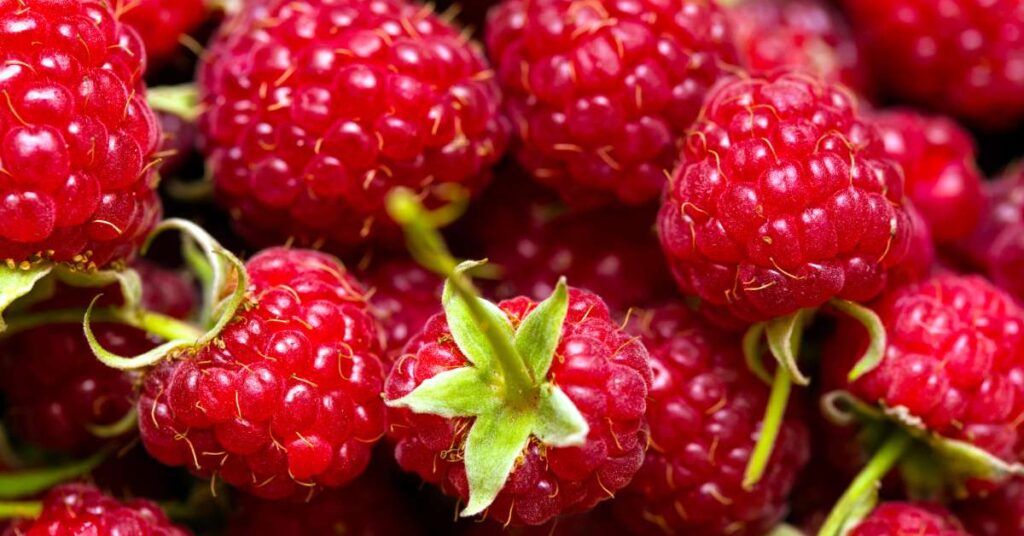Are you looking for a tasty and easy-to-grow berry for your garden? The Latham Raspberry might be just what you need. This hardy and reliable shrub produces sweet, red berries in mid-summer that are perfect for fresh eating, preserves, and pies.
You can grow Latham Raspberries in your backyard with minimal effort. They are cold-hardy, disease-resistant, and self-fruitful.
These plants thrive in organically rich, slightly acidic soil that stays moist but drains well. With proper care, you’ll enjoy a bountiful harvest of large, flavorful berries year after year.
To get started, you’ll need to plant, prune, and fertilize your Latham Raspberries correctly. With a little attention, you’ll soon have a thriving raspberry patch that provides delicious fruit for you and your family to enjoy all summer long.
Description of the Latham Raspberry
The Latham raspberry is a popular variety you’ll love growing in your garden. These sweet, red berries are perfect for fresh eating, jams, and jellies.
You’ll notice the Latham raspberry plant has an upright growth habit. It can reach a height of 4-5 feet tall. The canes are thorny, so be careful when handling them.
In spring, you’ll see clusters of pretty white flowers bloom. These flowers are self-fruitful, meaning you only need one plant to get fruit.
The berries ripen to a bright red color in mid-summer. They’re medium-sized and have a firm texture. You’ll find them easy to pick when ripe.

Latham raspberries are known for their hardiness. They were developed in Minnesota, so they can handle cold winters well.
Your Latham raspberry plants are perennials. They’ll come back year after year, giving you tasty fruit each summer.
The foliage is attractive too. In fall, the leaves add nice color to your garden before dropping for winter.
Remember, Latham raspberries are part of the Rubus genus. Their full scientific name is Rubus idaeus ‘Latham’.
Growing Conditions
You’ll love growing Latham raspberries in your garden! These berries thrive in full sun to part shade. They’re perfect for you if you live in a cooler climate.
Make sure your soil is just right. Latham raspberries like it slightly acidic. Aim for a pH between 5.6 and 6.2. They also love soil that’s rich in organic matter.
Here’s a quick soil prep checklist:
- Mix in compost
- Ensure good drainage
- Keep soil moist but not waterlogged
Your Latham raspberries will spread, so give them room. Plant them 2 to 3 feet apart. Rows should be 8 to 10 feet apart for good air flow.
Water is key! Keep the soil moist throughout the growing season. But remember, these plants don’t like wet feet. Good drainage is a must.
Latham raspberries are tough cookies. They’re cold-hardy and can handle harsh winters. They grow well in many zones across the US, especially in the Pacific Northwest.
Unique Planting and Care Instructions
Ready to grow delicious Latham raspberries? Let’s get started!
First, choose a sunny spot with good air circulation to prevent fungal diseases. Dig a hole about a foot deep and 3 feet wide.
Space your plants 2-3 feet apart in rows. Keep rows 8-10 feet apart. This gives your berries room to thrive!
Water your new plants deeply. Then add a 2-inch layer of mulch around them. This keeps the soil moist and stops weeds.
In late winter, it’s pruning time! Cut back old canes that already made fruit. Leave the new canes – they’ll give you berries this year.
Watch out for pests like aphids. If you see them, spray the plants with water to knock them off.
Fertilize your raspberries in early spring. Use a balanced fertilizer to keep them healthy and productive.
Keep an eye out for powdery mildew. If you spot it, remove affected leaves right away.
Thin out excess suckers in spring. This helps your main plants stay strong.

Harvesting & Uses
Latham raspberries are a joy to harvest. You’ll know they’re ready when the fruits turn a deep red color and easily come off the plant.
Pick your berries every few days during the harvest season. This usually happens in mid-summer. The harvest season starts about 2 months after the spring bloom time.
Be gentle when picking to avoid crushing the delicate fruit. Cup your hand beneath each berry and gently pull it off.
Birds love raspberries too, so you might want to cover your plants with netting to protect your harvest.
Latham raspberries are versatile in the kitchen. You can eat them fresh, bake them into pies, or turn them into sweet treats. They’re great for:
- Making jams and jellies
- Adding to smoothies
- Topping yogurt or ice cream
- Freezing for later use
To freeze your berries, spread them on a baking sheet and pop them in the freezer. Once frozen, transfer to freezer bags for long-term storage.
Latham raspberries are firm and hold up well to preserving. Try making homemade preserves to enjoy your harvest year-round.
Remember to leave some berries on the plant. The seeds inside bird droppings can help spread raspberry plants to new areas.

Leave a Reply